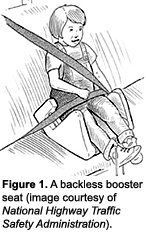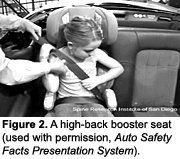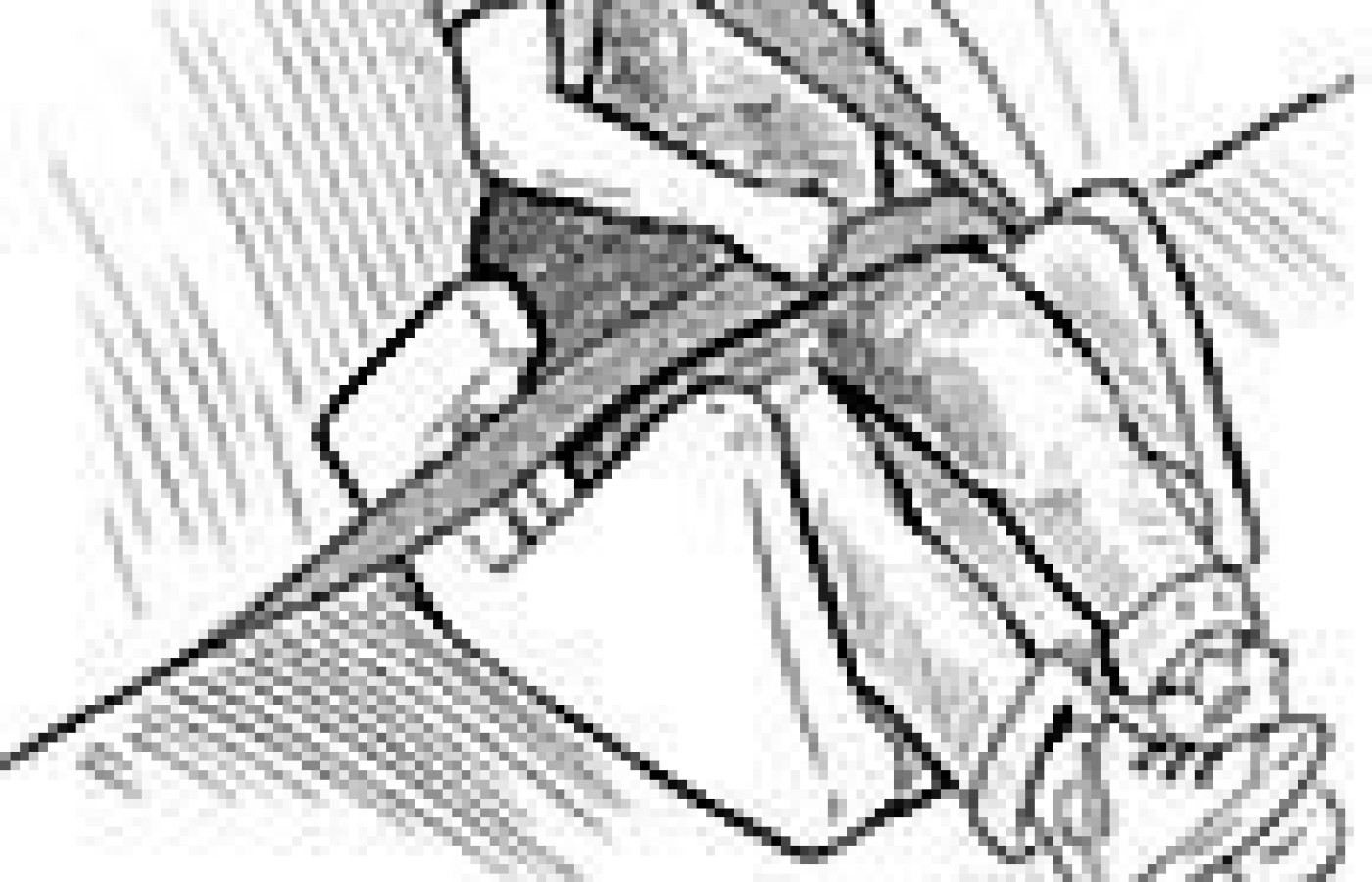New York's highest court of appeals has held that no-fault insurers cannot deny no-fault benefits where they unilaterally determine that a provider has committed misconduct based upon alleged fraudulent conduct. The Court held that this authority belongs solely to state regulators, specifically New York's Board of Regents, which oversees professional licensing and discipline. This follows a similar recent ruling in Florida reported in this publication.
Booster Seats: Why Go on Killing Our Children?
Automobile seats are designed to comfortably contain adult occupants. Of more critical importance, these seating systems, which include, inter alia, the seat belt and shoulder harness, were designed to optimally protect adult occupants in the unhappy event of a high-velocity crash. Are children at a disadvantage? Yes, for two reasons.
One reason is that the lap portion of the safety webbing is designed to distribute high-acceleration loads across the bony pelvis in the event of a frontal collision. In youngsters, this belt will typically ride up over the pelvic brim such that the child bears all of the force over the soft abdomen, with viscera being crushed between spine and belt. In more severe loading, spinal injuries can occur. Often these occur in collisions that adults, riding restrained in the front seat, do not perceive as severe. Because of the resiliency of the pediatric spinal column, gross dislocations and spontaneous reductions can occur, which are difficult to find later without very careful attention to MRI details. For the sake of trivia, this has been termed "spinal cord injury without radiographic abnormality" (SCIWORA).
Are these injuries uncommon? In one small study, the authors reported that in children with abrasions over the abdomen from the seat belt (the so-called "seat belt sign"), nearly 50 percent of the children had life-threatening bowel lacerations requiring emergent resection.
The other reason kids are at a disadvantage in high-velocity crashes is related to the shoulder sash or shoulder harness. Whereas in adults, it crosses safely over the shoulder in the region of the midclavicular line, in children sitting lower in the seat, it crosses dangerously across the neck, threatening both the spine and vital vascular structures in the neck.

The booster seat exerts its main effect by simply elevating the youngster in the seat, so that both the lap belt and shoulder harness fit the child more like they do an adult. Studies have demonstrated that youngsters using booster seats and standard restraints are much safer than youngsters using the restraints without the booster. You can find more information on the Web site of the National Highway Traffic Safety Institute (NHTSA). However, as it turns out, you can't trust everything you read, even from the government.
There are two kinds of booster seats. The most basic kind is a simple seat booster: the so-called backless booster seat. See Figure 1. The other type is a seat bottom/back combination: the high-back booster. Most of these also have a back high enough to serve an additional important function as a head restraint. Most also have lateral head protection to prevent lateral flexion excursions in the even more unhappy event of a side-impact collision. See Figure 2.
If you visit the NHTSA Web site, you will find that it informs visitors (unless it has changed recently) that both types of booster seats are equally effective at reducing injuries. But as it turns out, that is not actually the case. A recent study demonstrated that the high-back booster reduced injuries by a very commendable 70 percent, while the backless booster was shown to be no more effective at reducing injuries than seat belts without the booster.1

How can we explain this extreme disparity? My guess would be that the original researchers included both the high-back and the impotent, backless type in the study, and compared their lumped, safety-enhancing effect in a direct comparison with children of the same age and sex in comparable crashes who had no booster seats. The reported combined effectiveness was 59 percent; this is a frequently cited figure. Thus, the ineffectiveness (zero percent) of the backless booster would have been obscured by the high (70 percent) effectiveness of the high-back type. My advice would be to exhort your patients to replace those useless backless boosters with high-back boosters immediately.
How Many Parents Use Boosters Correctly?
In another recent survey, it was reported that about 33 percent of parents did not use booster seats at all, while 33 percent of those who did use them used them incorrectly.2 The proportion of backless types was not reported, but I would consider these "inappropriate" as well, in light of the above-mentioned study, so this number is probably conservative.
We might ask, what motivates the proper use of booster seats? Is it parental concern for the safety of their darling children? Not exactly. In a recent survey, 70 percent of adults said that the motivating factor for them was a law requiring booster seat use.3 This observation was confirmed in a before-and-after survey conducted in Indiana. The authors of the study reported a 50 percent increase in the use of booster seats after enactment of laws requiring them.4 As heartless as that may seem, we should not be too surprised. In the U.S., before laws went into effect, seat belt use hovered around 12 percent. Now seat belt use is about 70 percent or a little higher; however, we still lag well behind most other industrialized nations, where compliance is better than 95 percent. It seems unlikely that 82 percent of Americans were unaware of the safety offered by seat belts.
Rules of Thumb for Booster Usage
There are a few simple ways to determine whether the child should be using a booster seat. Children should ride in a booster seat until they are at least 57 inches tall. Once they have reached this height, if the child cannot sit all the way back against the vehicle's seat back and bend the knees over the edge of the seat, he or she should remain in a booster. If the seat belt rides up over the abdomen or if the shoulder portion rides over the neck, the child needs to remain in a booster seat. Also, check state laws: Some states require children to remain in a booster until 6 or 8 years of age.
Where Do You Fit In?
As a physician, you are the front line for your patients when it comes to motor-vehicle safety. Where else are they going to get this important and potentially life-saving information - from the TV, billboards, church meetings or perhaps their employer? Not a chance. Not only are you the most reliable source for the information, but you also have much higher credibility than most of the other sources they might get it from. The result will be that your patients will be more likely to follow your advice. How do you accomplish this enlightenment? Why not get a couple of booster seats and have a special meeting with your patients one night, or put a piece in your clinic newsletter or on your Web site? Who said chiropractors don't routinely save lives?
References
- Arbogast KB, Kallan M, Durbin DR. "Effectiveness of High Back and Backless Belt Positioning Booster Seats in Side-Impact Crashes." 49th Association for the Advancement of Automotive Medicine Conference. Massachusetts, 2005:201-213.
- O'Neil J, Meritt S, Talty J. "Observed Frequency of Misuse of Booster Seats." 50th Annual Meeting of the Association for the Advancement of Automotive Medicine. Chicago, 2006.
- Bingham CR, et al. Factors influencing the use of booster seats: a state-wide survey of parents. Accid Analysis Prev 2006;38:1028-1037.
- O'Neil J. "Observed Frequency of Booster Seat Usage After Legislation." 50th Annual Meeting of the Association for the Advancement of Automotive Medicine. Chicago, 2006.



